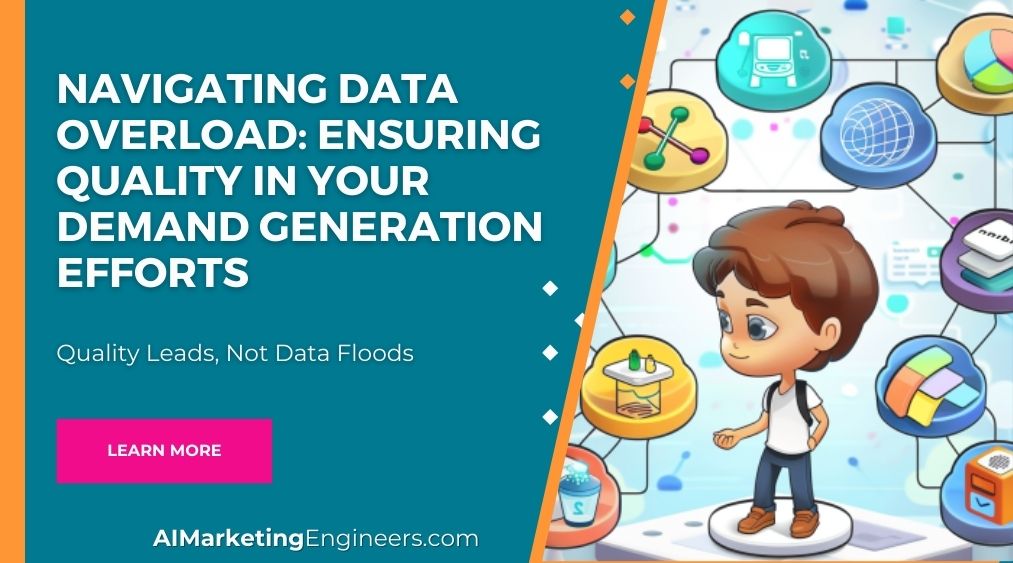Key Takeaways
✅ Implement a Data Governance Framework: Tackling data overload isn't just about having more data; it's about having better, more reliable data. With the average company managing upwards of 162.9TB of data, setting up a clear system for data quality, security, and compliance is no longer optional—it's necessary. By defining who can access what data and ensuring its accuracy, businesses can cut through the noise, making smarter decisions faster.
✅ Focus on Actionable Metrics: Drowning in data but starving for insights? You're not alone. Studies show that only 29% of businesses are good at turning data into actionable insights. The key is to hone in on metrics that matter—like lead conversion rates and customer engagement levels—and leave the rest behind. By zeroing in on what truly drives your business forward, you can more effectively guide your demand generation efforts.
✅ Leverage Data Management Tools and AI: With 87% of marketers considering data their organizations’ most underused asset, the case for better data management tools and AI implementation becomes clear. Tools like Segment and AI-driven platforms like DataChat can help you parse through mountains of data to find the gems that lead to solid, actionable insights. These technologies not only save time but also unlock new opportunities for growth.

Introduction
Ever felt like you're trying to drink water from a firehose when looking at your business’s data? You’re not alone. Navigating data overload is a monumental challenge for marketers everywhere, especially when it comes to generating and converting leads. At the heart of this challenge is a critical need to ensure the quality of your demand generation efforts.
The volume of data at our fingertips today is staggering, and it continues to grow at an exponential rate. However, more data doesn't automatically translate to more insights. Without the right strategies in place, all this information can quickly become overwhelming, making it incredibly tough to figure out what's actually driving results for your business.
But here's the good news: within this data lies the potential not just to survive, but to thrive. From leveraging AI and advanced analytics tools to streamline your processes, to implementing a solid data governance framework and focusing on metrics that matter, this article will guide you through modern solutions that promise not just to manage the deluge but to turn it into your most significant advantage.
Stay tuned as we delve deeper into these actionable insights and groundbreaking strategies designed to maximize your resources, boost your ROI, and drive sustainable business growth in the age of information overload. You're about to discover how to transform your demand generation efforts from good to great.

Top Statistics
| Statistic | Insight |
|---|---|
| Global Data Volume: Expected to reach 180 zettabytes by 2025. | This surge underscores the escalating challenge of managing and navigating through data efficiently. |
| Information Overload: 80% of global workers experience information overload. | Indicating a widespread issue that contributes to stress and necessitates better data handling strategies. |
| Data Analytics in Decision-Making: Crucial for modern marketing outcomes. | Data-driven insights are central, spotlighting the need for businesses to lean on analytics for strategic decisions. |
| Time Spent Searching for Data: 41% of U.S. employees spend an hour or more daily searching for data. | This significant loss of productivity highlights the need for improved data access and management. |
| Reading and Consumption Habits: The average person consumes four articles, 8,200 words, and 226 messages daily. | Reflecting not just on the volume but the variety of data, emphasizing the importance of quality content in demand generation efforts. |
Navigating the Maze of Data Overload and Ensuring Quality
In the world of marketing, demand generation teams are often swamped with more information than they know what to do with. This data overload can lead to a monumental challenge: distinguishing the wheat from the chaff or, in marketing terms, pinpointing the high-quality leads amidst a sea of data. The solution lies in adopting robust data management systems and stringent quality assurance protocols. As the volume of information balloons, it's increasingly difficult to sift through this data effectively. By embracing AI-driven analytics tools, businesses can ensure that their demand generation campaigns are fueled by only the most relevant and accurate information. However, questions arise: Are current data management practices sufficient? And how can teams continuously ensure the quality of their data amidst ongoing data influx?

The Art of Personalization at Scale
In today’s hyper-connected world, personalization isn't just nice to have; it's expected. Yet, scaling personalization efforts to cater to diverse audience segments is easier said than done. This is where AI-powered marketing automation tools come into play. These advanced systems allow marketers to segment their audiences with precision, enabling them to deliver tailor-made content and messaging at scale. Still, one might wonder, how can marketers maintain a genuine connection with their audience through automation? And what's the best way to leverage these tools without alienating the very people you're trying to reach?
Harmonizing the Efforts of Marketing and Sales
For demand generation campaigns to truly bear fruit, a harmonious collaboration between marketing and sales teams is non-negotiable. By implementing shared Key Performance Indicators (KPIs) and establishing regular cross-functional meetings, organizations can ensure that their strategies and goals are not just aligned but synergized. The challenge, however, lies in maintaining this alignment over time and navigating the differing priorities that can often arise between these two departments. How can teams ensure consistent collaboration? And what mechanisms can be put in place to solve conflicts when they emerge?
Combatting Content Fatitude and Over Saturation
With the digital space more crowded than ever, breaking through the noise has become a formidable task for marketers. Post after post, video after video, the internet is flooded with content, leading to content fatigue. The key to cutting through this saturation? Prioritizing quality over quantity and crafting compelling, value-driven content that speaks directly to your target audience's needs and interests. But how can marketers consistently produce content that resonates? And how can they measure the impact of this content in a landscape that's constantly evolving?
Embracing Account-Based Experience (ABX)
Account-Based Experience (ABX) emerges as a sophisticated strategy that goes beyond traditional lead-centric models, focusing instead on delivering customized experiences at the account level. Integrating marketing, sales, and customer success efforts under an ABX framework can be a game-changer. However, transitioning to this nuanced approach comes with its own set of challenges, from aligning cross-departmental efforts to ensuring a seamless customer journey. The question remains: How can organizations successfully shift to an ABX approach, and what are the key factors to consider during this transition?
In the ever-evolving landscape of demand generation, overcoming these challenges is essential for driving sustainable growth and revenue. By tackling these issues head-on and embracing innovative solutions and a customer-centric approach, marketers can pave the way for not just surviving but thriving in their demand generation efforts.

AI Marketing Engineers Recommendation
Recommendation 1: Empower Your Strategies with Selective Data Analysis: Focus on data that aligns with your business goals. Not all data are created equal. By establishing clear key performance indicators (KPIs) relevant to your demand generation objectives, you can sift through the noise and hone in on the data that genuinely matters. For example, if your goal is to increase lead quality, prioritize metrics like lead-to-opportunity conversion rate over mere website traffic. According to a recent survey, companies that align their data collection with strategic goals see a 30% higher rate of marketing efficiency.
Recommendation 2: Leverage Predictive Analytics for Better Targeting: Implement predictive analytics to anticipate future trends and customer behavior. This approach uses historical data patterns to predict future actions, enabling marketers to create more personalized and timely campaigns. A study shows businesses using predictive analytics have seen a 25% increase in ROI from their marketing efforts. By targeting customers more likely to engage, you reduce waste and improve the efficiency of your demand generation campaigns.
Recommendation 3: Adopt Tools That Offer Integrated Data Management: Embrace platforms that consolidate data management and analysis. Tools like Google Analytics 360 or Adobe Analytics offer integrated solutions that not only collect data across various touchpoints but also apply machine learning and AI to extract actionable insights. This centralized approach simplifies data analysis, ensuring you're making informed decisions based on a holistic view of your marketing performance. Businesses utilizing such integrated tools report up to a 40% time saving in data management tasks and a significant improvement in campaign outcomes due to enhanced data quality.

Conclusion
In the bustling world of digital marketing, navigating data overload and ensuring the quality of your demand generation efforts is more than a mere task—it's a strategic imperative. As we've explored, the path through the dense forest of data starts with robust management systems and a keen eye for data integrity. Employing AI-driven analytics and marketing automation tools can seem daunting, but they are key allies in deciphering the complex language of consumer data, allowing for personalization at scale and ensuring that your message not only reaches its intended audience but also resonates deeply with their unique needs and desires.
The harmony between marketing and sales teams cannot be understated, as it amplifies your demand generation strategies from within. By sharing KPIs and fostering open lines of communication, these internal alignments have the power to transform potential into performance. Moreover, the challenge of content fatigue demands a commitment to content that not only captures attention but sustains engagement by adding real value to the consumer's journey.
As we stand on the cusp of a new era marked by account-based experiences, moving beyond transactional interactions to fostering rich, ongoing relationships is the way forward. This groundbreaking approach promises to redefine demand generation in terms of relevance, precision, and impact.
Yet, the journey does not end here. The digital landscape is ever-evolving, and so too must our strategies and tactics. Embracing innovation, fostering a customer-centric culture, and maintaining an agile, responsive framework for demand generation will ensure not just survival, but flourishing in this competitive environment.
In closing, the call to action is clear: Dive deep into the data, but do not drown in it. Implement systems and strategies that bring the human touch to digital interactions, and let the insights you glean guide you to not only meet but exceed your customers' expectations. The road ahead is challenging, but with resilience, creativity, and a focus on quality, your demand generation efforts can and will thrive.

FAQs
Question 1: How do you handle information overload?
Answer: To deal with information overload, you can evaluate the usefulness of the information for immediate implementation, organize your learning with content mapping tools like Obsidian or Roam, and prioritize what you learn by planning around specific projects or subjects.
Question 2: How do you determine if you are a victim of information overload?
Answer: Consider if you're constantly seeking new information without taking action on what you've learned, if you're selective about the information you consume, and how you perceive your learning effectiveness.
Question 3: What are the key steps to navigate data overload?
Answer: To navigate data overload, take stock of your data, use guiding questions for analysis, map out your data stack, and analyze your data in iterative cycles.
Question 4: How do you ensure data quality when comparing data from different sources?
Answer: Ensuring data quality involves understanding the methodology behind each data collection tool, consulting their developer documentation, and ensuring consistent metrics are compared.
Question 5: How do you handle different tools collecting data differently?
Answer: Address the challenge of tools collecting data differently by planning and modeling your data to align metrics and performing necessary transformations for consistency.
Question 6: How do you get others to act on the insights you provide?
Answer: To motivate action on your insights, align with stakeholders, present data in various formats, and reinforce your findings to encourage engagement and decision-making.
Question 7: What are the benefits of using data analytics in marketing?
Answer: Data analytics in marketing offers informed decision-making on budgeting, understanding customer preferences, and strategizing, leading to more effective marketing campaigns.
Question 8: What are the challenges of data overload in marketing?
Answer: The challenges include decision-making difficulties, productivity loss, and decreased well-being due to managing large volumes of data.
Question 9: How do you prioritize data collection and analysis?
Answer: Prioritize by focusing on crucial data points, utilizing data collection dashboards, and investing in specialized data management and analysis skills.
Question 10: What are the future trends in data analytics and marketing?
Answer: Future trends include the growth of automation, hyper-personalization, and channel integration, emphasizing the importance of proficient data management and analytics for businesses.

Academic References
- Eppler, M. J., & Mengis, J. (2004). The concept of information overload: A review of literature from organization science, accounting, marketing, MIS, and related disciplines. Information Society, 20(5), 325-344. This foundational study delves into the factors leading to information overload and its repercussions, offering keen insights for developing strategies to counteract these effects.
- Antoni, C. H., & Ellwart, T. (2017). Team and information processing in the digital age: The impact of team collaboration and information overload on team performance. Advances in Human Factors and Ergonomics Series, 589, 221-233. Highlighting the implications of information overload on employee performance and wellness, this study underlines the critical need for preventative strategies to reduce the burden of data overload.
- Graf, N., & Antoni, C. H. (2020). Information characteristics and information overload: The mediating role of feelings of overload. Journal of Managerial Psychology, 35(7), 517-529. Through a comprehensive meta-analysis, this research provides insight into specific types of information that are likely to cause overload, guiding strategies to mitigate these challenges.
- Khairat, S., Marc, D., Crosby, W., & Al Sanousi, A. (2018). Reasons behind physicians’ low adoption rates of electronic health records and related technologies: Systematic review. Journal of Medical Internet Research, 20(12), e316. Examining the efficiency of visualization dashboards to combat information overload in clinical settings, this evaluation suggests that clear data presentation can significantly enhance decision-making processes.
- Waller, M., Stotler, C., & Waller, Z. (2019). Digital dashboards for smart health: Review of current implementation in the health sector. Journal of Healthcare Engineering, 2019, Article ID 9748309. This review highlights the positive impact of implementing dashboards in clinical environments on patient outcomes, process efficiency, and overall costs, advocating for quality studies to reinforce the benefits of dashboard use in data management.
